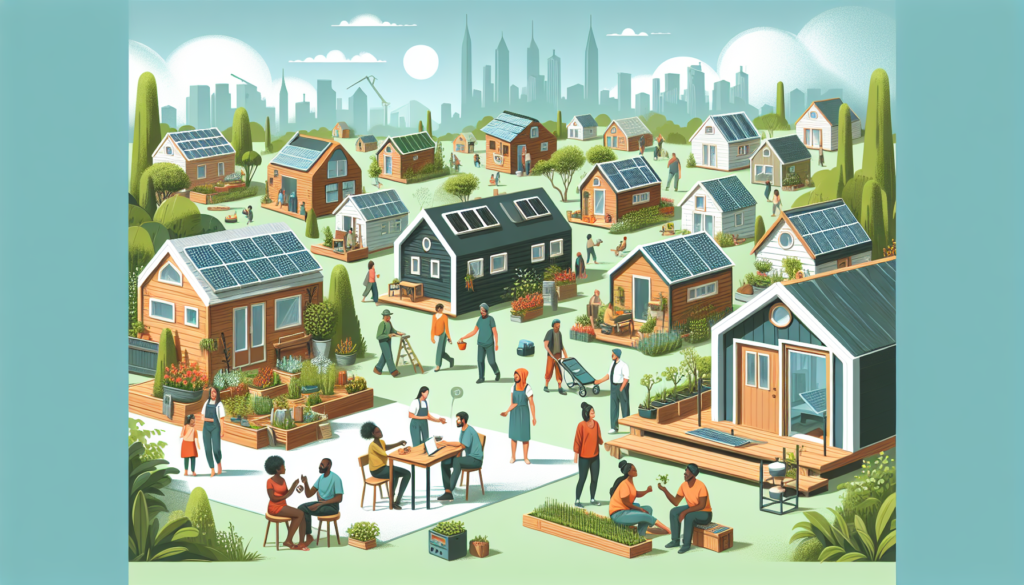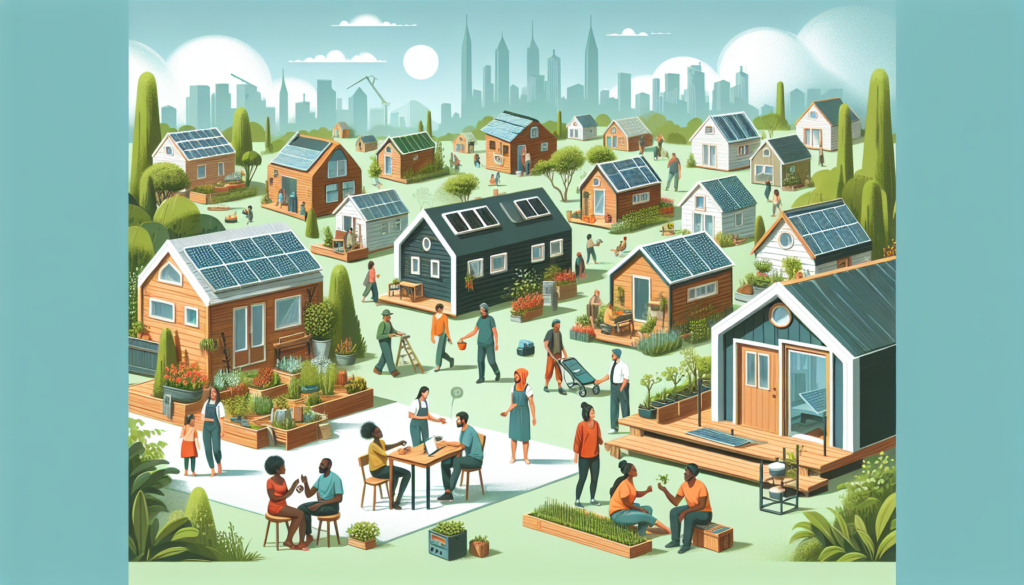Imagine the joy of living in a close-knit community, where neighbors become friends and green spaces bring everyone together. Have you ever wondered how to create such a community, specifically centered around tiny homes? In this article, we will explore the step-by-step process of starting a tiny home community from scratch. From finding the perfect location to establishing guidelines and fostering a sense of belonging, this guide will provide you with the tools and inspiration to turn your vision into a vibrant and thriving tiny home community. Get ready to embark on an exciting journey towards creating a unique and fulfilling living experience for yourself and others.
Choosing the Location
When it comes to starting a tiny home community from scratch, one of the first and most critical steps is choosing the right location. Several factors should be considered during this process.
Consider zoning regulations
Before selecting a location, it is crucial to familiarize yourself with the zoning regulations in that area. Different cities and municipalities may have specific rules and restrictions when it comes to tiny homes. Ensure that the location you choose is zoned for residential use and allows for the construction and placement of tiny homes.
Find available land
Once you understand the zoning regulations, it’s time to find available land for your tiny home community. Look for areas that are easily accessible and preferably close to amenities such as grocery stores, hospitals, and recreational facilities. Consider the size and shape of the land and whether it can accommodate the number of tiny homes you plan to build.
Assess the accessibility and infrastructure
Another crucial factor to consider when choosing a location is accessibility and existing infrastructure. Determine if the land has proper access to roads and utilities such as water, electricity, and sewage. If the infrastructure is not already in place, consider the cost and feasibility of installing these systems.
Developing the Vision
Once you have chosen a suitable location for your tiny home community, it’s time to develop a clear vision for the project.
Define the purpose and goals of the community
Start by defining the purpose and goals of your tiny home community. Are you aiming to create an affordable housing option? Or maybe you want to promote sustainable living? Clearly articulate what you hope to achieve with your community, as this will guide your decision-making process throughout the project.
Determine the target demographic
Next, identify the target demographic for your community. Are you catering to young professionals, retirees, or families? Understanding the needs and preferences of your intended residents will help shape the amenities and services you offer in the community.
Decide on community amenities
To attract residents, it’s essential to offer appealing amenities within your tiny home community. Consider amenities such as communal spaces, gardens, fitness centers, or even a clubhouse. These amenities will enhance the living experience for your residents and add value to your community as a whole.

Understanding Legal Requirements
Before diving into the development process, it’s crucial to familiarize yourself with the legal requirements and regulations applicable to your tiny home community.
Research local regulations and permits
Every jurisdiction has its own set of regulations, permits, and building codes that you must comply with when constructing a tiny home community. Research and understand these requirements to ensure your project is in full compliance.
Obtain necessary licenses and insurance
In addition to zoning and building permits, you may need to obtain specific licenses and insurance for your community. Consult with local authorities to determine the necessary licenses and ensure you have the appropriate insurance coverage for your project.
Establish legal agreements and contracts
When starting a community project, it is essential to have legal agreements and contracts in place. This includes creating agreements with contractors, vendors, and potentially future residents. Consult with legal professionals to draft these agreements to protect yourself and the community.
Creating a Business Plan
Developing a comprehensive business plan for your tiny home community is crucial for its success.
Perform a market analysis
Before proceeding further, conduct a thorough market analysis. Study the demand for tiny home communities in your chosen area and identify potential competitors. This analysis will help you determine if there is a viable market for your project and guide your decision-making process moving forward.
Determine the financial feasibility
Evaluate the financial feasibility of your tiny home community project by considering the construction costs, ongoing maintenance expenses, and potential revenue streams. This analysis will help you determine if the project is financially viable and what pricing structure you should establish.
Develop a marketing and sales strategy
A well-thought-out marketing and sales strategy is essential to attract residents to your tiny home community. Determine the most effective ways to reach your target demographic, whether it’s through online advertising, social media, or local marketing efforts. Develop a strategy that highlights the unique aspects of your community and emphasizes the benefits of tiny home living.

Securing Funding
Finding the necessary funds to finance your community project is a crucial step in the process.
Explore financing options
Consider different financing options for your tiny home community. This may include traditional loans from banks or credit unions, as well as alternative financing options, such as grants or crowdfunding campaigns. Explore all possibilities and choose the financing option that best suits your project.
Consider crowdfunding or investor partnerships
Crowdfunding platforms can be a useful tool to secure funds for your tiny home community. Additionally, consider partnering with investors who are interested in sustainable housing projects. These partnerships can provide the necessary capital and expertise to help bring your vision to life.
Create a budget and financial projections
To manage your finances effectively, create a detailed budget and financial projections for your community project. Consider all expenses, including land acquisition, construction, utilities, marketing, and ongoing maintenance. Having a clear understanding of your financial commitments will help you stay on track and ensure the financial success of your community.
Designing the Community
Once you have secured funding, it’s time to focus on designing your tiny home community.
Develop a site plan and layout
Work with architects and urban planners to develop a site plan and layout for your community. Consider factors such as placement of homes, common areas, parking spaces, and landscaping. Aim for an efficient and aesthetically pleasing layout that maximizes space and promotes community interaction.
Explore different housing options
Tiny homes come in various sizes and designs. Consider offering a variety of housing options within your community to cater to different needs and preferences. This may include single-story or loft-style homes, varying in square footage and design. Provide options that are comfortable, functional, and customizable for residents.
Consider common areas and shared spaces
An essential aspect of any community is the inclusion of common areas and shared spaces. Design communal spaces such as parks, gardens, or recreational areas where residents can gather and interact. Additionally, consider amenities like a community center or a small business hub that encourages socialization and collaboration among residents.
Building the Infrastructure
With the design plans in place, it’s time to start building the infrastructure for your tiny home community.
Install utilities (water, electricity, sewage)
Ensure that the necessary utilities, such as water, electricity, and sewage systems, are installed properly and efficiently. Partner with professionals to handle the installation to ensure compliance with local regulations and the safety and functionality of your community.
Construct roads and parking areas
Constructing roads and parking areas is essential to ensure smooth accessibility within your community. Properly designed and well-maintained roads will enhance the overall livability and functionality of your community. Consider adding designated parking spaces for residents’ tiny homes and visitor parking for guests.
Create waste management systems
Implement a comprehensive waste management system within your community to ensure cleanliness and sustainability. This may include recycling facilities, composting areas, or partnerships with local waste management services. Encourage residents to adopt environmentally conscious practices to minimize waste and maximize resource efficiency.
Establishing Community Guidelines
To promote a harmonious living environment, it is essential to establish community guidelines and rules for your tiny home community.
Develop a code of conduct
Create a code of conduct that outlines the expected behaviors and values within your community. This code should promote respect, cooperation, and responsible living. Communicate these guidelines clearly to residents and enforce them consistently to maintain a positive and inclusive community atmosphere.
Create rules and regulations
In addition to a code of conduct, establish clear rules and regulations that govern specific aspects of community living. This may include guidelines for noise levels, pet ownership, parking regulations, or architectural standards. These rules ensure that residents are aware of their responsibilities and contribute to a cohesive and well-maintained community.
Establish a governing structure
To effectively manage your tiny home community, establish a governing structure that ensures transparent decision-making and dispute resolution. This structure may include a homeowner’s association or community board that represents the interests and concerns of the residents. Foster open communication and collaboration among residents to create a thriving and engaged community.
Finding and Selecting Residents
With your community infrastructure in place, it’s time to focus on finding and selecting the right residents for your tiny home community.
Advertise the community
Utilize various marketing channels to advertise your tiny home community. Make use of online platforms, social media, local publications, and community events to showcase the unique features and benefits of living in your community. Engage with potential residents and provide them with the necessary information to make an informed decision.
Screen and interview potential residents
Once you start receiving applications, implement a screening process to ensure that prospective residents align with the community’s vision and values. Conduct interviews to get to know the applicants personally and assess their suitability for the community. Consider factors such as compatibility, financial stability, and commitment to communal living.
Establish an application process
Establish a clear and streamlined application process to facilitate the selection of residents. Develop an application packet that includes necessary documentation, such as income verification and references. Clearly communicate expectations and requirements to potential residents, ensuring a transparent and fair selection process.
Maintaining and Managing the Community
Once your tiny home community is up and running, ongoing maintenance and management are crucial for its long-term success.
Implement maintenance and repair systems
Develop maintenance and repair systems to ensure that the community remains in good condition. This may include regular inspections, scheduled maintenance, and prompt response to repair requests. Consider hiring a property management team or outsourcing maintenance services to professionals to ensure efficient and reliable upkeep.
Manage finances and bookkeeping
Maintaining solid financial management is essential for the sustainability of your tiny home community. Implement effective bookkeeping practices and financial tracking tools to ensure accurate record-keeping and comprehensive financial reporting. Regularly review and analyze your community’s financial health to make informed decisions and plan for future improvements.
Handle conflict resolution
In any community, conflicts or disputes may arise. Develop a structured process for conflict resolution to address any issues that may arise among residents. Establish clear communication channels and designate individuals or committees responsible for mediating conflicts and finding solutions. Encourage open dialogue, active listening, and empathy to maintain a harmonious living environment.
Starting a tiny home community from scratch requires careful planning, attention to legal requirements, and a clear vision for the community. By following these steps and considering the various aspects involved, you can create a thriving and sustainable tiny home community that offers a unique and rewarding living experience for all residents.

